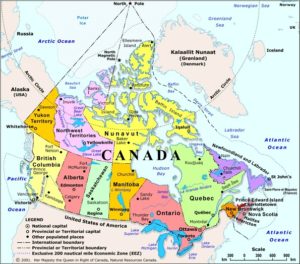
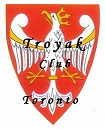
HAPPY NEW YEAR 2020
BONNE ANNÉE 2020

SZCZĘŚLIWEGO NOWEGO ROKU 2020
FELIZ AÑO NUEVO 2020

TROYAK EXECUTIVE TEAM is informing all members, colleagues, collectors and Polonia at large, that Club meetings taking place at John Paul II Polish Cultural Centre, 4300 Cawthra Rd. (just south of Hwy. 403), Mississauga, Ontario. The new members are always welcome. www.polishculturalcentre.ca
ADRES SPOTKAÑ KLUBOWYCH ! Zarząd Główny Klubu “Troyak” informuje wszystkich członków kolekcjonerów, sympatyków oraz całą Polonię, że spotkania klubowe odbywają się w Polskim Centrum Kultury im. Jana Pawła II, przy 4300 Cawthra Rd. (na południe od autostrady 403), Mississauga, Ontario. Zapraszamy nowych członków do prężnego. Klubu “Troyak”. www.polishculturalcentre.ca

“TROYAK” CLUB NEXT MEETINGS …
NASTĘPNE SPOTKANIA KLUBU “TROYAK” …
12th January 2020 @ 4:30 p.m. … Annual General Meeting
26th January 2020
23rd February 2020
8th March 2020 …
XVII Polish – Canadian Coin, Stamp & Collectibles Show 2020
29th March 2020 @ 4:30 p.m.
26th April 2020 …
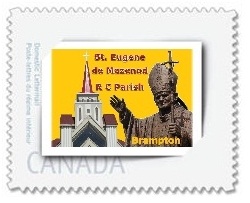
TROYAK CLUB @ St. John Paul II – 100
Birthday Anniversary Celebration 2020
Sunday 10 May 2020
9:00 a.m. to 4 p.m.
@
Our Lady Queen Of Poland Parish
Parafia Matki Bożej Królowej Polski
625 Middlefield Rd, Scarborough, ON M1V 5B8
Displays of Coins, Medals, Stamps, Collectibles dedicated to
St. John Paul II by Troyak Club Members.

TROYAK CLUB @ St. John Paul II – 100
Birthday Anniversary Celebration 2020
Saturday 16 May 2020 … 12:00 p.m. to 8:00 p.m.
Sunday 17 May 2020 … 9:00 a.m. to 8:00 p.m.
@
St. Casimir’s Church
www.kazimierz.org
Parish Hall … 156 Roncesvalles Ave. Toronto, ON M6R 2L4
Stamp Exhibit … Pope John Paul II on World Stamps and
displays of Coins, Medals, Collectibles dedicated to
St. John Paul II by Troyak Club Members.

TROYAK CLUB @ St. John Paul II – 100
Birthday Anniversary Celebration 2020
Sunday 24 May 2020
9:00 a.m. to 4 p.m.
@
John Paul II Polish Cultural Centre,
4300 Cawthra Rd. Mississauga, ON L4Z 1V8
Displays of Coins, Medals, Stamps, Collectibles dedicated to
St. John Paul II by Troyak Club Members.

TROYAK CLUB @ St. John Paul II – 100
Birthday Anniversary Celebration 2020
Sunday 31 May 2020
9:00 a.m. to 4 p.m.
@
Our Lady of Perpetual Help Catholic Church
Kosciół Matki Boskiej Nieustającej Pomocy
5 Oblate St. St. Catharines, ON L2M 5C5
Displays of Coins, Medals, Stamps, Collectibles dedicated to
St. John Paul II by Troyak Club Members.

31st May 2020
21st June 2020

July & August 2020 – Summer break … Letnie wakacje …
TROYAK CLUB @ Roncesvalles Polish Festival 2020
Saturday, September 12th … Sunday, September 13th, 2020
https://polishfestival.ca www.kazimierz.org
27th September 2020
4th October 2020 @ 9:00 a.m. to 4:00 p.m. …
Mississauga’s 5th Annual Fall Show
25th October 2020
29th November 2020

Fukudenkai – dom nadziei
Fukudenkai – house of hope
www.poczta-polska.pl
Dnia 30 września 2019 r. został wprowadzony do obiegu znaczek pocztowy o wartości 3,30 zł emisji “Fukudenkai – dom nadziei”. Na znaczku przedstawiony został, wykonany techniką origami, bocian biały na tle flagi Japonii; wzdłuż dolnej krawędzi znaczka umieszczono napis: POLSKA, wzdłuż lewej krawędzi – napis: FUKUDENKAI – DOM NADZIEI, a w prawym górnym rogu – oznaczenie wartości: 3,30 zł. Znaczek wydrukowano techniką offsetową, na papierze fluorescencyjnym, w formacie: 31,25 x 39,5 mm, w nakładzie 180 000 sztuk. Arkusz zawiera 9 szt. znaczków. Z tej okazji została wydana również koperta FDC. Autor projektu znaczka: Roch Stefaniak. Arkusik emisji “Fukudenkai – dom nadziei” wejdzie w skład abonamentu na arkusiki.
Wartość: 3,30 zł … autor projektu znaczka: Roch Stefaniak;
autorka rysunku: Wiktoria Kosterska; liczba znaczków: 1;
nakład: 180 000 szt.; technika druku: offset;
format znaczka: 31,25 x 39,5 mm; papier: fluorescencyjny;
arkusz sprzedażny: 9 znaczków;
data wprowadzenia do obiegu: 30 września 2019 r.
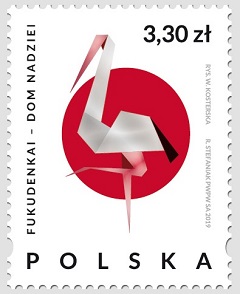
Fukudenkai – house of hope … denomination: 3,30 PLN;
number of stamps in set: 1; print run: 180.000 pcs.;
printing techniques: offset; paper: fluorescent;
stamp size: 31,25 x 39,5 mm; 9 stamps in sheet;
number of FDC: 1; author: Roch Stefaniak;
circulation date: 30th September 2019.

150. Rocznicy urodzin Mahatmy Gandhiego
150th Anniversary of the birth of Mahatma Gandhi
www.poczta-polska.pl
Dnia 30 września 2019 r. został wprowadzony do obiegu znaczek pocztowy o wartości 3,30 zł emisji “150 rocznica urodzin Mahatmy Gandhiego”. Na znaczku przedstawiona została postać Mahatmy Gandhiego; wzdłuż lewej krawędzi znaczka umieszczono napisy: POLSKA i 150. ROCZNICA URODZIN MAHATMY GANDHIEGO oraz oznaczenie wartości: 3,30 zł. Znaczek wydrukowano techniką rotograwiurową, na papierze fluorescencyjnym, w formacie 31,25 x 39,5 mm, w nakładzie 120 000 sztuk. Arkusz sprzedażny zawiera 50 szt. znaczków. Z tej okazji została wydana również koperta FDC. Autor projektu: Maciej Jędrysik.
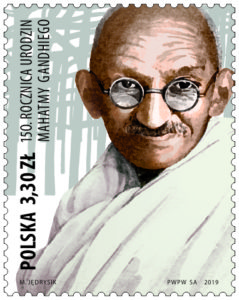
150th anniversary of the birth of Mahatma Gandhi …
denomination: 3,30 PLN; number of stamps in set: 1 (50 pcs in sheet);
print run: 120 000 pcs.; printing techniques: photogravure;
paper: fluorescent; number of FDC: 1;
stamp size: 31,25 x 39,5 mm; author: Maciej Jędrysik;
circulation date: 30th September 2019.

300 lat Poznańskich Bambrów
300 years of Poznań Bambers
www.poczta-polska.pl
Wartość: 3,30 zł … autor projektu: Joanna Fleszar;
liczba znaczków: 1; nakład: 180 tys. szt.; technika druku: offset;
format znaczka: 43 x 31,25 mm; papier: fluorescencyjny;
arkusze sprzedażne: 12 znaczków;
data wprowadzenia do obiegu: 19 października 2019 r.
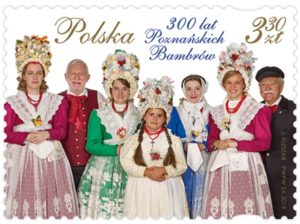
300 years of Poznań Bambers … denomination: 3,30 PLN;
number of stamps in set: 1; print run: 180.000 pcs.;
printing techniques: offset; paper: fluorescent;
stamp size: 43 x 31,25 mm; 12 stamps in sheet;
number of FDC: 1; author: Joanna Fleszar;
circulation date: 19th October 2019.

75. Rocznica wyzwolenia Bredy przez żołnierzy gen. Stanisława Maczka
75th Anniversary of the liberation of Breda by the soldiers
of General Stanisław Maczek
www.poczta-polska.pl
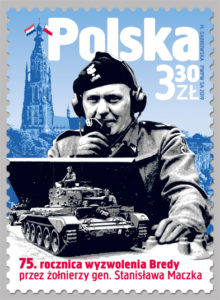
Dnia 26 października 2019 r. został wprowadzony do obiegu znaczek pocztowy o wartości 3,30 zł emisji “75.rocznica wyzwolenia Bredy przez żołnierzy gen. Stanisława Maczka”. Na znaczku przedstawiona została postać gen.Stanisława Maczka, wieża katedry w Bredzie oraz czołg. Znaczek wydrukowano techniką rotograwiurową, na papierze fluorescencyjnym, w formacie 31,25 x 43 mm, w nakładzie 150 000 sztuk. Arkusz sprzedażny zawiera 50 szt. znaczków. Z tej okazji została wydana również koperta FDC. Autor projektu: Marzanna Dąbrowska.
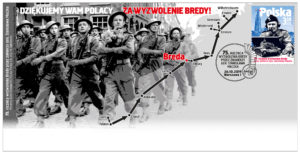
75th anniversary of the liberation of Breda by the soldiers of General Stanisław Maczek … denomination: 3,30 PLN; number of stamps in set: 1 (50 pcs in sheet); print run: 150 000 pcs.; printing techniques: photogravure; paper: fluorescent; stamp size: 31,25 x 43 mm; number of FDC: 1; author: Marzanna Dąbrowska; circulation date: 26th October 2019.

100. Rocznica urodzin Henryka Tomaszewskiego
100th Anniversary of the Birth of Henryk Tomaszewski
www.poczta-polska.pl
Dnia 20 listopada 2019 r. została wprowadzona do obiegu kartka pocztowa z nadrukowanym znakiem opłaty pocztowej, emisji: 100. rocznica urodzin Henryka Tomaszewskiego. Wartość nominalna znaku opłaty pocztowej z oznaczeniem literowym A odpowiada wartości nominalnej znaczka pocztowego używanego do uiszczenia opłaty za ekonomiczną przesyłkę listową nierejestrowaną, w tym kartkę pocztową, w obrocie krajowym, w formacie S o masie do 500 g.
W prawym górnym rogu strony adresowej kartki nadrukowano znak opłaty pocztowej , na którym przedstawiono grafikę z fragmentem twarzy mima ; wzdłuż prawej krawędzi znaczka umieszczono napis POLSKA oraz oznaczenie wartości: A. W części ilustracyjnej kartki znajdują się: *- fotografia autorstwa Jana Bortkiewicza, przedstawiająca Henryka Tomaszewskiego, znanego tancerza i choreografa, założyciela Wrocławskiego Teatru Pantomimy; na tle twarzy artysty logo obchodów 100-lecia urodzin w formie okularów, * – w centralnej części ilustracyjnej kartki : tytuł emisji: “100.rocznica urodzin Henryka Tomaszewskiego”. Kartkę o wymiarach 148 x 105 mm wydrukowano jednostronnie, techniką offsetową, na kartonie białym, w nakładzie 8000 sztuk. Autor projektu kartki: Jan Konarzewski.
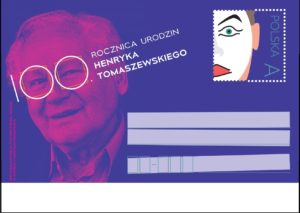
100th Anniversary of the Birth of Henryk Tomaszewski …
denomination: 3,30 PLN; number of stationeries in set: 1;
print run: 8.000 pcs; printing technique: offset;
card size: 148 x 105 mm; author: Jan Konarzewski;
release date: 20th November 2019.

100. Rocznica urodzin Ryszarda Kaczorowskiego
– ostatniego Prezydenta RP na Uchodźstwie
100th Anniversary of the Birth of Ryszard Kaczorowski
– the Last President of the Republic of Poland in Exile
www.poczta-polska.pl
Dnia 24 listopada 2019 r. została wprowadzona do obiegu kartka pocztowa z nadrukowanym znakiem opłaty pocztowej, emisji: 100. rocznica urodzin Ryszarda Kaczorowskiego – ostatniego Prezydenta RP na Uchodźstwie. Wartość nominalna znaku opłaty pocztowej z oznaczeniem literowym A odpowiada wartości nominalnej znaczka pocztowego używanego do uiszczenia opłaty za ekonomiczną przesyłkę listową nierejestrowaną, w tym kartkę pocztową, w obrocie krajowym, w formacie S o masie do 500 g.
W prawym górnym rogu strony adresowej kartki nadrukowano znak opłaty pocztowej , na którym przedstawiono wizerunek Prezydenta Ryszarda Kaczorowskiego ; wzdłuż lewej krawędzi znaczka umieszczono napis POLSKA, a w prawym górnym rogu oznaczenie wartości: A. W części ilustracyjnej kartki znajduje się nazwa emisji: ,,100. rocznica urodzin Ryszarda Kaczorowskiego – ostatniego Prezydenta RP na Uchodźstwie” oraz Insygnia Prezydenckie II Rzeczpospolitej Polskiej: Krzyż z Wielką Wstęgą i Gwiazdą Dziesiątego Wielkiego Mistrza Orderu Orła Białego – Ryszarda Kaczorowskiego; w tle godła Rzeczpospolitej Polskiej. Kartkę o wymiarach 148 x 105 mm wydrukowano jednostronnie, techniką offsetową, na kartonie białym, w nakładzie 8000 sztuk. Autor projektu kartki: Andrzej Gosik.
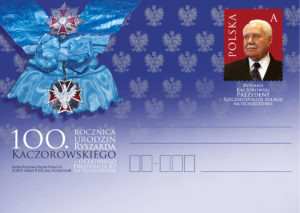
100th Anniversary of the Birth of Ryszard Kaczorowski
– the Last President of the Republic of Poland in Exile …
denomination: 3,30 PLN; number of stationeries in set: 1;
print run: 8.000 pcs; printing technique: offset;
card size: 148 x 105 mm; author: Andrzej Gosik;
release date: 24th November 2019.

Prawa wyborcze kobiet w Polsce
Women’s electoral rights in Poland
www.poczta-polska.pl
Wartość: 3,30 zł … autorka projektu znaczka: Agnieszka Sancewicz;
liczba znaczków: 1; nakład: 216 000 szt.; technika druku: offset;
format znaczka: 31,25 x 39,5 mm; arkusz sprzedażny: 12 znaczków;
papier: fluorescencyjny; data wprowadzenia do obiegu: 28 listopada 2019 r.
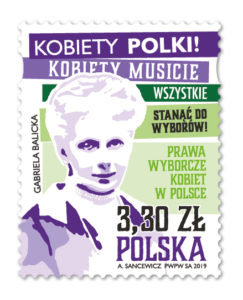
Women’s electoral rights in Poland … denomination: 3,30 PLN;
number of stamps in set: 1; print run: 216.000 each pcs;
printing technique: offset; stamp size: 31,25 x 39,5 mm;
number of FDC: 1; author: Agnieszka Sancewicz;
circulation date: 28th November 2019.

Wyklęci przez komunistów żołnierze niezłomni
– Łukasz Ciepliński „Pług”
www.nbp.pl
Narodowy Bank Polski ma wyłączne prawo emitowania znaków pieniężnych Rzeczypospolitej Polskiej, w tym monet i banknotów kolekcjonerskich. Wszystkie monety i banknoty emitowane przez NBP są prawnym środkiem płatniczym w Polsce. 16 października 2019 roku Narodowy Bank Polski wprowadził do obiegu srebrną monetę o nominale 10 zł z serii Wyklęci przez komunistów żołnierze niezłomni Łukasz Ciepliński ps. „Pług”.
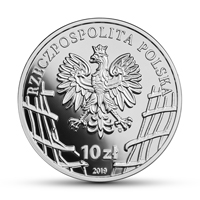
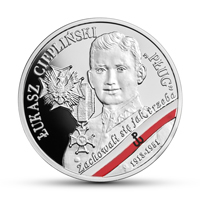
Nominał 10 zł … Metal: Ag 925/1000; Stempel: lustrzany, tampondruk; Średnica: 32,00 mm; Masa: 14,14 g; Brzeg (bok): gładki; Nakład: do 13 000 szt.; Projektant monety: Dobrochna Surajewska; Emitent: NBP; Na zlecenie NBP monety wyprodukowała Mennica Polska S.A. Na awersie srebrnej monety przedstawiono rozerwane kraty więzienne. Na każdej polskiej monecie znajdują się: nominał, napis „Rzeczpospolita Polska”, rok emisji, wizerunek orła ustalony dla godła Rzeczypospolitej Polskiej. Na rewersie monety znajdują się wizerunki: Łukasza Cieplińskiego „Pługa”, Orderu Orła Białego, orderu Virtuti Militari, biało-czerwonej flagi z symbolem Polski Walczącej oraz napis „Zachowali się jak trzeba”.
Łukasz Ciepliński urodził się 26 listopada 1913 r. w Kwilczu. Ukończył szkołę powszechną i uczęszczał do Korpusu Kadetów w Rawiczu. W 1936 r. został absolwentem Szkoły Podchorążych Piechoty w Komorowie-Ostrowi Mazowieckiej. Od 1936 r. służył w 62 Pułku Piechoty w Bydgoszczy. W wojnie obronnej 1939 r. jako dowódca kompanii przeciwpancernej walczył w bitwie nad Bzurą i w Puszczy Kampinoskiej. Gen. Tadeusz Kutrzeba odznaczył go osobiście Orderem Virtuti Militari V klasy za zniszczenie z działka przeciwpancernego sześciu niemieckich czołgów i dwóch wozów dowódczych. Brał udział w obronie Warszawy. Z misją zorganizowania trasy przerzutowej przedostał się na Węgry, skąd po przeszkoleniu wracał do Polski. Został aresztowany przez ukraińską policję i uwięziony w Sanoku, jednak udało mu się stamtąd uciec.
W Rzeszowskiem działał w strukturach Organizacji Orła Białego/ZWZ/AK. Nie tylko brał udział w akcjach bojowych, ale też zorganizował świetnie funkcjonującą strukturę wywiadu i kontrwywiadu, likwidującą niemieckich konfidentów. To podlegli mu konspiratorzy przechwycili części pocisków V-1 i V-2 oraz wykryli jedną z tajnych kwater Hitlera. W ramach akcji „Burza” brał udział w wyzwalaniu Rzeszowa. Jako przeciwnik ujawniania się AK-owców przed drugim okupantem − sowieckim − przeszedł do konspiracji. W nocy z 7 na 8 października 1944 r. podjął nieudaną próbę odbicia 400 żołnierzy AK uwięzionych przez NKWD na Zamku w Rzeszowie. Działał w kolejnych antysowieckich organizacjach: NIE, Delegaturze Sił Zbrojnych na Kraj, w końcu w Zrzeszeniu Wolność i Niezawisłość. W styczniu 1947 r. stanął na czele IV Zarządu Głównego WiN – bezpośredniego kontynuatora organizacyjnego, osobowego i ideowego Armii Krajowej. Rozwijał głównie działalność wywiadowczą i propagandową.
Urząd Bezpieczeństwa aresztował go 28 listopada 1947 r. w Zabrzu. W katowni bezpieki przy ul. Rakowieckiej w Warszawie przeszedł trwające trzy lata brutalne przesłuchania, które sam tak określił: „W czasie śledztwa leżałem skatowany w kałuży własnej krwi. Mój stan psychiczny był w tych warunkach taki, że nie mogłem sobie zdawać sprawy z tego, co pisał oficer śledczy”. Pod wpływem bicia Ciepliński ogłuchł na jedno ucho, a kiedy nie mógł już chodzić o własnych siłach, na przesłuchania wnoszono go na kocu. 14 października 1950 r. krzywoprzysiężny sąd skazał go „na pięciokrotną karę śmierci, utratę praw publicznych i obywatelskich praw honorowych na zawsze oraz przepadek całego mienia”. Przed Wojskowym Sądem Rejonowym w Warszawie mówił: „Staję przed zarzutem zdrady narodu polskiego, a przecież już w młodości życie moje Polsce ofiarowałem i dla niej chciałem pracować. Dla mnie sprawa polska była największą świętością”.
16 grudnia 1950 r. w majestacie stalinowskiego bezprawia sąd wyższej instancji utrzymał wyrok w mocy, a prezydent Bierut decyzją z 20 lutego 1951 r. nie skorzystał z prawa łaski. 1 marca 1951 r. prezes IV Zarządu Głównego WiN ppłk Łukasz Ciepliński został zamordowany strzałem w tył głowy w więzieniu przy ul. Rakowieckiej. Ciepliński wiedział, że nie będzie miał pogrzebu, tylko pod osłoną nocy zostanie wrzucony do jakiegoś bezimiennego dołu. Dlatego tuż przed śmiercią połknął medalik z Matką Boską. Dotąd nie wystarczyło to, by zidentyfikować jego szczątki na Łączce Powązek Wojskowych w Warszawie. Informacja: Tadeusz Płużański.

The Enduring Soldiers Accursed by the Communists
– Łukasz Ciepliński ‘Pług’
www.nbp.pl
Narodowy Bank Polski holds the exclusive right to issue the currency of the Republic of Poland, including collector coins and banknotes. All coins and banknotes issued by NBP are legal tenders in Poland. On 16 October 2019, Narodowy Bank Polski issued into circulation a silver coin from the series “The Enduring Soldiers Accursed by the Communists” – Łukasz Ciepliński ‘Pług’ with a face value of 10 zł.


Face value: 10 zł … Metal: Ag 925/1000; Finish: proof, pad printing; Diameter: 32.00 mm; Weight: 14.14 g; Edge (side): plain; Mintage: up to 13,000 pcs; Coin designer: Dobrochna Surajewska; Issuer: NBP; The coins, commissioned by NBP, were struck by Mennica Polska S.A.
The obverse of the silver coin features prison bars torn apart. The reverse of the coin carries the images of Łukasz Ciepliński “Pług”, the Order of the White Eagle, the Order of Virtuti Militari, and a white‑and-red flag with the symbol of Fighting Poland, and the inscription “Zachowali się jak trzeba” (They acted as they should). All Polish coins feature: face value, the image of the Eagle established as the state emblem of the Republic of Poland inscription: Rzeczpospolita Polska, year of issue.
Łukasz Ciepliński was born in the village of Kwilcz on 26 November 1913. He graduated from elementary school and enlisted in the Cadet Corps in Rawicz. In 1936, he graduated from the Infantry Cadet School in Komorowo, Ostrów Mazowiecka. In 1936, he joined the 62nd Infantry Regiment in Bydgoszcz. In the defensive war of 1939, he was in command of an antitank company and fought in the Battle of the Bzura and in the Kampinos Forest. General Tadeusz Kutrzeba personally awarded Ciepliński the Silver Cross of the Order of Virtuti Militari for destroying six German tanks and two commander’s vehicles with an anti-tank gun. He participated in the defense of Warsaw. Assigned with the mission to organise a transit route, Ciepliński crossed over to Hungary, and after receiving military training returned to Poland. He was arrested by Ukrainian policemen and imprisoned in Sanok, but managed to escape. In the environs of Rzeszów, Ciepliński was active in the Organisation of the White Eagle/ZWZ (Union for Armed Struggle)/the Home Army. Not only was he involved in combat actions, but he also organised a successful intelligence and counterintelligence network responsible for liquidating German informers.
His unit intercepted V-1 and V-2 rocket parts and his operatives located a secret headquarters of Adolf Hitler. Ciepliński participated in Operation Tempest, which led to the liberation of Rzeszów. As he opposed the idea which required Home Army soldiers to reveal themselves to the other occupying power, the Soviets, he joined an underground movement. On the night of 7 October 1944, he conducted an unsuccessful operation to free 400 Home Army soldiers imprisoned by the NKVD (the Soviet secret service agency) at Rzeszów Castle. Ciepliński continued his activity in other anti-Soviet organisations, including the NIE resistance movement, the Armed Forces Delegation for Poland and, ultimately, in the WIN (Freedom and Independence) association. In January 1947, he was elected president of the 4th Management Board of WIN, the direct organizational, personal and ideological successor of the Home Army. He mainly focused on intelligence and propaganda activity. Ciepliński was arrested by the UB (Department of Security) in Zabrze on 28 November 1947. In the UB torture house at Rakowiecka Street in Warsaw, he was brutally interrogated for three years. This is what he said about the interrogation: ”During the interrogation, I was lying in a puddle of my own blood. In these conditions, my mental state was such that I could not be aware of what the investigating officer was writing”. As a result of the beatings, he went deaf in one ear, and when he could no longer walk, he was carried for interrogations on a blanket.
On 14 October 1950, the court condemned him in a perjurious ruling too, “five death sentences, the loss of public rights and honorary civil rights forever, and the forfeiture of all property.” He told the Military District Court in Warsaw, ”I am facing the charge of treason against the Polish nation, but after all, I offered my life to Poland already in my youth and wanted to work for it. For me, the Polish cause was the most sacred thing.” On 16 December 1950, in the majesty of Stalin-era lawlessness, the higher court upheld the ruling, and then President Bolesław Bierut, pursuant to the decision of 20 February 1951, refused to grant clemency in the case. On 1 March 1951, the President of the 4th Management Board of WiN, Lieutenant Colonel Łukasz Ciepliński, was murdered with a shot to the back of his head in the basement of the prison at Rakowiecka Street. Ciepliński was aware that he would not be buried, and that his body would be dumped under cover of the night into some nameless hole. Therefore, just before death, he swallowed a scapular medal. However, this has so far been insufficient to identify his remains in the Meadow of the Powązki Military Cemetery in Warsaw. Info: Tadeusz Płużański.

Stulecie odzyskania przez Polskę niepodległości
– Wojciech Korfanty
www.nbp.pl
Narodowy Bank Polski jest centralnym bankiem państwa odpowiadającym za politykę pieniężną i stabilność cen. Jego funkcje określa Konstytucja Rzeczypospolitej Polskiej i ustawa o NBP. NBP ma wyłączne prawo emisji pieniądza. Jako bank centralny nie prowadzi rachunków bankowych obywateli, nie przyjmuje od nich lokat, nie udziela kredytów. Prowadzi natomiast obsługę budżetu państwa, a także podmiotów sektora finansów publicznych. Gromadzi rezerwy walutowe państwa i zarządza nimi. Pełni funkcję banku banków, tworząc warunki do działania systemu bankowego. Jest również jednym z najważniejszych ośrodków naukowo-analitycznych w dziedzinie ekonomii i rynków finansowych. 5 listopada 2019 roku Narodowy Bank Polski wprowadził do obiegu srebrną monetę o nominale 10 zł oraz złotą monetę o nominale 100 zł z serii „Stulecie odzyskania przez Polskę niepodległości” – Wojciech Korfanty.
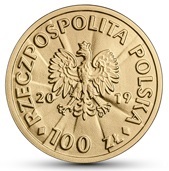
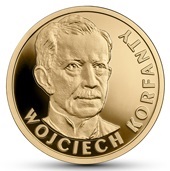
Nominał 100 zł … metal: Au 900/1000; stempel: lustrzany;
średnica: 21,00 mm; masa: 8,00 g; obrzeże (bok): gładkie;
nakład: do 1500 szt.; Projektant monety: Dobrochna Surajewska;
Emitent: NBP; Na zlecenie NBP monety wyprodukowała
Mennica Polska S.A.
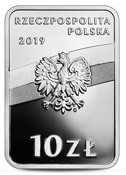
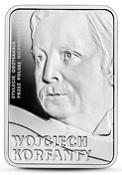
Nominał 10 zł … metal: Ag 925/1000; stempel: lustrzany;
wymiary: 32,00 × 22,40 mm; masa: 14,14 g; obrzeże (bok): gładkie;
nakład: do 13 000 szt.; Projektant monety: Dobrochna Surajewska;
Emitent: NBP; Na zlecenie NBP monety wyprodukowała
Mennica Polska S.A.; Zdjęcia Wojciecha Korfantego wykorzystane
do zaprojektowania monet pochodzą ze zbiorów
Narodowego Archiwum Cyfrowego.
Wojciech Korfanty (1873–1939) − polityk, przywódca II i III powstania śląskiego. Urodził się w pobożnej rodzinie górniczej w Siemianowicach Śląskich. Kształcił się w szkole ludowej, potem w gimnazjum, w którym założył konspiracyjne kółko samokształceniowe, za co w 1895 r. został wydalony ze szkoły. Studiował filozofię, prawo i ekonomię na Królewskim Uniwersytecie Wrocławskim. Studia ukończył w Berlinie w 1901 r. Poznał tam przywódców Ligi Narodowej. Od 1901 r. był redaktorem naczelnym „Górnoślązaka”, pisywał też do „Dziennika Berlińskiego”. Za antyniemieckie teksty został skazany na cztery miesiące więzienia (osadzono go we Wronkach), co przysporzyło mu popularności. Został członkiem tajnej Ligi Narodowej i w 1903 r. wystartował w wyborach do Reichstagu. W parlamencie Rzeszy przystąpił do Koła Polskiego, w którym wcześniej byli jedynie posłowie z Wielkopolski i Pomorza. Wystąpienia w parlamencie Rzeszy ujawniły jego wybitny talent oratorski. W następnym roku został też posłem do Landtagu, pruskiego parlamentu krajowego. W styczniu 1917 r. wygłosił słynne stwierdzenie: „Narodowo jesteśmy Polakami, a nie po polsku mówiącymi Prusakami”. W wystąpieniu w Reichstagu 25 października 1918 r. żądał przyłączenia ziem zaboru pruskiego do odradzającej się Polski, następnie wraz z innymi posłami Koła Polskiego opuścił parlament jako organ władzy obcego mu państwa.
W dniu 11 listopada 1918 r. został członkiem Naczelnej Rady Ludowej w Poznaniu, stanowiącej zalążek polskiej administracji w regionie. Po wybuchu powstania wielkopolskiego Korfanty z ramienia Rady kierował negocjacjami dyplomatycznymi, w wyniku których 16 lutego 1919 r. zawarto rozejm w Trewirze, przyznający odrodzonej Polsce znaczne obszary zaboru pruskiego. Ustalenia te potwierdził traktat wersalski z 28 czerwca 1919 r. Nie przyznano nam jednak m.in. ziem Górnego Śląska, o których losie miał przesądzić plebiscyt. Od grudnia 1919 r. Korfanty kierował Polskim Komitetem Plebiscytowym, a kiedy w trakcie kampanii wybuchło II powstanie śląskie (w sierpniu 1920 r.), stanął na jego czele. W marcu 1921 r. mimo intensywnej kampanii prowadzonej przez Korfantego Polacy przegrali plebiscyt. Wówczas wysunął propozycję podziału Śląska (tzw. linia Korfantego), w wyniku czego Polsce miała przypaść bardziej uprzemysłowiona część regionu. Korfanty podjął decyzję o strajku powszechnym irozpoczęciu trzeciego powstania, a 3 maja 1921 r. ogłosił się jego dyktatorem. W ciągu tygodnia Polacy osiągnęli „linię Korfantego”, a główne walki toczyły się 20−21 maja o Górę Świętej Anny. Równocześnie Korfanty rozpoczął negocjacje, a następnie doprowadził do zakończenia walk oraz korzystnego dla Polaków podziału spornych ziem.
Ostatecznie w październiku 1921 r. przyznano Polsce najbardziej uprzemysłowioną część Górnego Śląska, ze stolicą w Katowicach. W latach 1919–1922 Korfanty stał na czele Związku Ludowo-Narodowego (endecja) w Sejmie Ustawodawczym, a w kolejnym sejmie (1922–1928) został przywódcą Chrześcijańskiej Demokracji. Był przeciwnikiem zamachu majowego. We wrześniu 1930 r. został aresztowany i wtrącony do twierdzy brzeskiej. Po wypuszczeniu na wolność udał się na emigrację do Czechosłowacji. W 1937 r. działał w ugrupowaniach emigracyjnych − był współzałożycielem Frontu Morges i przywódcą chadeckiego Stronnictwa Pracy. Po długich staraniach wrócił do kraju w kwietniu 1939 r. Mimo licznych protestów został aresztowany przez rząd sanacyjny. Zwolniony z powodu wykrytej choroby nowotworowej, wkrótce zmarł 17 sierpnia 1939 r., a jego pogrzeb stał się wielką manifestacją patriotyczną. Pochowano go w Katowicach. Informacja: prof. Jan Żaryn.

100th Anniversary of Regaining Independence by Poland
– Wojciech Korfanty
www.nbp.pl
Narodowy Bank Polski is the central bank of the State, responsible for its monetary policy and price stability. The Bank’s functions are described in the Constitution of the Republic of Poland and the Act on NBP. NBP holds the exclusive right to issue the currency of the Republic of Poland. As the central bank, it does not provide accounts for the general public, accept deposits from or extend loans to individuals. It acts as a banker to the State budget and public sector entities. NBP also holds and manages the foreign exchange reserves of the State. Finally, it functions as a banker to banks, creating conditions for the operation of the Polish banking system. Narodowy Bank Polski is one of the most important research and analytical centres in the fields of economics and financial markets. On 5 November 2019, Narodowy Bank Polski issued into circulation collector coins of the series “100th Anniversary of Regaining Independence by Poland” – Wojciech Korfanty: a silver coin with a face value of 10 złoty and a gold coin with a face value of 100 złoty.


Face value 100 zł … Metal:Au 900/1000; Finish: proof;
Diameter: 21.00 mm; Weight: 8.00 g; Edge (side): plain;
Mintage: up to 1,500 pcs; Designer: Dobrochna Surajewska.


Face value 10 zł … Metal: Ag 925/1000; Finish: proof;
Dimensions: 32.00 x 22.40 mm; Weight: 14.14 g; Edge (side): plain;
Mintage: up to 13,000 pcs; Designer: Dobrochna Surajewska;
Issuer: NBP; The coins, commissioned by NBP, were struck
by Mennica Polska S.A. The photographs of Wojciech Korfanty
used for the design of the coins come from the collections
of the National Digital Archives.
Wojciech Korfanty (1873–1939) – politician, leader of the second and third Silesian Uprisings. Wojciech Korfanty was born into a religious miners’ family in Siemianowice Śląskie. He attended a people’s school, and then a middle school, where he set up an underground self-study club. This was the reason why in 1895 he was expelled from school. Korfanty studied philosophy, law, and economics at the University of Breslau. He graduated in Berlin in 1901. It was there that he got to know the leaders of the National League. From 1901 he worked as editor-in-chief of the daily “Górnoślązak” (The Upper Silesian) and he also contributed to “Dziennik Berliński” (The Berlin Journal). He was convicted to four months’ imprisonment (in the Wronki Prison) for his anti-German articles, which won him popularity. He joined the clandestine National League and stood for election to the Reichstag in 1903. In the Parliament of the Reich, he joined the Polish Club, which previously consisted only of deputies from Greater Poland and Pomerania.
The speeches he made in the Parliament of the Reich revealed his outstanding rhetorical talent. In the following year, he also became a member of the Landtag, the Prussian national parliament. In January 1917, he made the famous statement: “As a nation, we are Poles, not Polish-speaking Prussians”. In a Reichstag address on 25 October 1918, he demanded that the lands of the Prussian partition be included in resurgent Poland. Subsequently, together with other members of the Polish Club, he left the parliament considering it an authority of a foreign state. On 11 November 1918, he became a member of the Supreme People’s Council (Naczelna Rada Ludowa) in Poznań, which marked the beginning of Polish administration in the region. After the outbreak of the Greater Poland Uprising, Korfanty, as a representative of the Council, led the diplomatic negotiations as a result of which the Convention of Trier was signed on 16 February 1919, according to a significant area of the Prussian Partition to resurgent Poland. These arrangements were confirmed by the Treaty of Versailles on 28 June 1919. However, Poland was not allotted, among others, the territory of Upper Silesia, the future of which was to be decided in a plebiscite. From December 1919, Korfanty headed the Polish Plebiscite Committee and, when the 2nd Silesian Uprising broke out during the campaign (in August 1920), he became its leader.
In March 1921, despite the intensive campaign run by Korfanty, the plebiscite turned out to be a defeat for the Poles. He then came up with the proposal of dividing Silesia (along the so-called Korfanty line), as a result of which Poland would be allotted the more industrialised part of the region. Korfanty made the decision to call a general strike and start a third uprising. On 3 May 1921, he proclaimed himself its dictator. In the course of a week, the Poles reached the Korfanty line and the main fighting took place on 20-21 May for St. Anne’s Mountain. At the same time, Korfanty initiated negotiations, with his efforts leading to the end of the fighting and a division of the disputed territory in Poland’s favour. Eventually, in October 1921 Poland was allotted the most industrialised part of Upper Silesia with the capital in Katowice. Between 1919–1922, Korfanty served as the leader of the Popular National Union (National Democrats) in the Legislative Sejm, and in the subsequent Sejm (1922– 1928) he became the leader of the Christian Democracy. He opposed the May 1926 coup of Józef Piłsudski. In September 1930, he was arrested and imprisoned in the Brest Fortress. After being released, he emigrated to Czechoslovakia. In 1937, he actively participated in emigration groupings – as a co-founder of the Morges Front and the leader of the Christian democratic Labour Party. After much effort, he returned to Poland in April 1939. Despite strong protests, he was arrested by the Sanation government. After being diagnosed with cancer, he was released and died soon afterward on 17 August 1939. His funeral turned into a huge patriotic demonstration. Info: Prof. Jan Żaryn.


Postal History Of Newfoundland
www.canadapost.ca https://postagestampguide.com
According to history, the first letter mailed from Canada was sent from St. John’s, Newfoundland, in 1527 by a Capitan John Rut of the Royal Navy. It was a progress report to King Henry VIII. In the centuries that followed this dispatch, postal service between England and her colony was at best, an erratic private enterprise. In the 18th century, mail service was at the discretion of visiting sea Capitan’s, who usually charged a shilling for each letter.
Newfoundland’s first postmaster, Simon Solomon, was appointed in 1805. Postmaster Solomon, a St. John’s jeweler, ran the post office as part of his shop. In 1857 adhesive stamps were introduced. These first stamps showed the heraldic flowers and crown of the United Kingdom. From that date until 1949, when Newfoundland entered Confederation, the province issued its own postage stamps. (49-I-20)
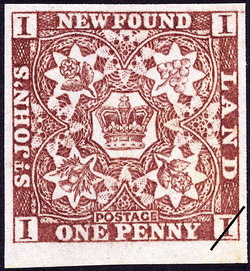
Rose, Thistle and Shamrock … Stamp Info … Date of Issue: January 1, 1857; Denomination: 1d; Quantity: 70,000; Perforation or Dimension: Imperforate = Non dentelé; Printer: Perkins, Bacon & Company; Postal Administration: Newfoundland. Designed by William Leamon Solomon. Designed by Charles Henry Darling.
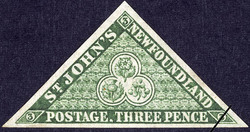
Rose, Thistle and Shamrock … Stamp Info … Date of Issue: January 1, 1857; Denomination: 3d; Quantity: 10,000; Perforation or Dimension: Imperforate = Non dentelé; Printer: Perkins, Bacon & Company; Postal Administration: Newfoundland. . Designed by William Leamon Solomon. Designed by Charles Henry Darling.
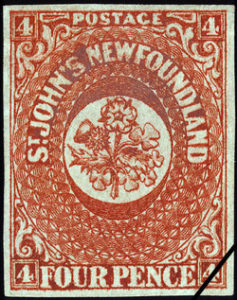
Rose, Thistle and Shamrock … Stamp Info … Date of Issue: January 1, 1857; Denomination: 4d; Quantity: 5,000; Perforation or Dimension: Imperforate = Non dentelé; Printer: Perkins, Bacon & Company; Postal Administration: Newfoundland. . Designed by William Leamon Solomon. Designed by Charles Henry Darling.
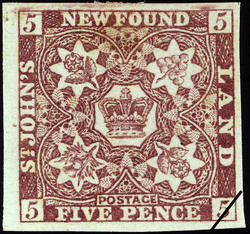
Rose, Thistle and Shamrock … Stamp Info … Date of Issue: January 1, 1857; Denomination: 5d; Quantity: 11,000; Perforation or Dimension: Imperforate = Non dentelé; Printer: Perkins, Bacon & Company; Postal Administration: Newfoundland. . Designed by William Leamon Solomon. Designed by Charles Henry Darling.

Red River Resistance: PermanentTM domestic rate stamps
www.canadapost.ca
This booklet of 10 PermanentTM domestic rate stamps marks the Red River Resistance of 1869-70, a defining moment in the history of Manitoba, the Métis people and Canada. The Red River Resistance began as an assertion of Métis land and cultural rights at a time when the Canadian government was purchasing their traditional lands. Supporters formed a provisional government and, under the leadership of Louis Riel, negotiated with the Canadian government. The Métis’ “Bill of Rights,” outlining their terms for joining Confederation, formed the basis of the Manitoba Act, which made Manitoba Canada’s fifth province on July 15, 1870.
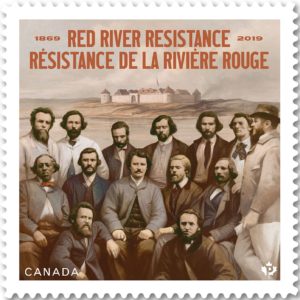
The stamp illustration, by Gérard DuBois, is based on two historical works: a lithograph of Fort Garry by Henry James Warre (1848) and a photograph of Louis Riel and his provisional government councillors (1870). Stamp Value: PermanentTM (domestic rate); Quantity Produced: 130,000; Dimensions: 38 mm x 38 mm; Stamp Designer: Paprika; Issue Date: November 6, 2019.
Red River Resistance: Official First Day Cover … Mark the event that changed Manitoba’s history with this Official First Day Cover marking the Red River Resistance. The stamp is cancelled in Winnipeg, Manitoba, with a mark inspired by the infinity symbol that holds special significance to the Métis people. Quantity Produced: 7,000; Dimensions: 190 mm x 112 mm.

2019 … Special Edition Proof Dollar – Louis Riel: Father of Manitoba
www.canadapost.ca www.mint.ca
In issuing the 2019 Special Edition Proof Dollar, the Royal Canadian Mint acknowledges, honours and celebrates the unique history of the Métis Nation. We would like to express our sincere gratitude to President Clément Chartier of the Métis National Council, President David Chartrand of the Manitoba Metis Federation, and Mr. Norman Fleury, for their guidance and collaboration in this tale of two nations whose histories are intertwined.
This year’s special edition proof dollar highlights the contributions of Louis Riel (1844-1885), and those of the Métis Nation, to the story of Canada. A defender of Métis rights and a catalyst for change, Louis Riel was born 175 years ago in Saint-Boniface, in the province he later founded. In fact, it was 150 years ago that the National Committee led by Riel drafted an initial list of rights for the Métis Nation—a declaration in which land claims and language rights were preconditions to Manitoba’s entry into Confederation. This coin, which commemorates Louis Riel’s place in history, is a celebration of the cultural legacy of the Métis Nation and its resilience. The struggles of the past haven’t disappeared; they continue to echo through generations. There is hope, however, through the acknowledgment of Canada’s troubled history and in the recognition of a founding people’s sacrifices.
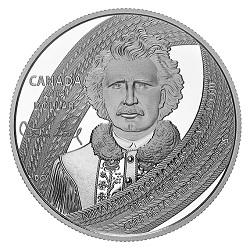
Face value: 1 dollar … Composition99.99% pure silver;
Mintage: 15,000; Finish: proof; Weight: 23.17 g; Edge: serrated;
Diameter: 36 mm; Certificate: serialized;
ArtistDavid Garneau (reverse), Susanna Blunt (obverse).
Design: Designed by Métis artist David Garneau, your coin features a portrait of Louis Riel (1844-1885). The Métis Nation leader and founder of Manitoba is wearing his fur-trimmed buckskin jacket, which is adorned with traditional floral beadwork. His Conventry sash forms one looped half of the emblem of the Métis Nation: an infinity sign that represents the unification of two cultures (European and Indigenous) and the immortality of the Métis Nation. The sash bears Riel’s title in three languages: Michif (NIIKAANIIW POOR LA NAASYOON LII MICHIF), English (MÉTIS NATION LEADER) and French (CHEF DE LA NATION DES MÉTIS). An engraved reproduction of Louis Riel’s signature appears below the word “CANADA”, the year “2019” and the face value, “DOLLAR”. The obverse features the effigy of Her Majesty Queen Elizabeth II by Susanna Blunt.
“The Royal Canadian Mint’s coin pays a fitting tribute to the eternal leader of the Métis Nation. Louis Riel’s vision and sacrifice not only shaped the struggle of the Métis people to secure their place within the Canadian Federation but also gave birth to western Canada itself.” Clément Chartier, President of the Métis National Council.
“’My people will sleep for 100 years, and when they awake, it will be the artists who give them back their spirit.’ While scholars have yet to determine when or if Louis Riel said this, it is a sentiment that motivates many Métis artists, including me. Political action woke the Métis in the 1960s-80s and drove the leadership to have us recognized in the Constitution. It is now up to the painters, sculptors, poets, musicians, authors, filmmakers, beaders, and other cultural workers to awaken the Métis spirit and deepen the expression of contemporary Métis identity. I feel this responsibility keenly. I am honoured to have participated in this coin design. It remembers and honours not just our leader, but also the resilience of the Métis people.” David Garneau, Artist.
Louis Riel (1844-1885) … Louis Riel was born on 22 October 1844 in Saint-Boniface, in present-day Manitoba. During the Red River Resistance of 1869-1870, the Provisional Government of Assiniboia (under Riel’s leadership) negotiated Manitoba’s entry into Confederation, which was contingent on the recognition of Métis rights and land claims. While the Manitoba Act became law in 1870, the execution of Thomas Scott cast a pall over the provisional government and Riel was forced into exile. He returned to Batoche (Saskatchewan) to lead a second armed resistance movement, the 1885 Northwest Resistance, which ended in defeat against federal troops. He was charged with high treason and hanged on 16 November 1885. Today, Riel is remembered as a champion of Métis nationhood and rights, and since 1992, the founding father of Manitoba.
Did you know … * This current decade (2011-2020) was declared the “Decade of the Métis Nation.” * In Manitoba, the third Monday of every February is a provincial holiday known as Louis Riel Day. * According to the 2016 census, the Métis population in Canada includes more than 587,000 people. Métis Nation citizens, originally of mixed Indigenous and European ancestry emerged as a distinct Indigenous nation in the northwest in the 18th and 19th centuries. * Today, the Métis Nation Homeland encompasses the Prairie Provinces and a contiguous part of British Columbia, Ontario, the Northwest Territories, and the Northwestern United States. * The earliest recorded use of the Métis flag was on 19 June 1816 at the Battle of Seven Oaks. * The multi-use “ceinture flechée” worn by the voyageurs during the fur trade era evolved into the now-iconic garment of the Métis Nation, whose history and identity are expressed through each pattern and colourful strand. Featured on this coin, Louis Riel’s sash is a Coventry sash, a popular style that was mass-produced on a loom in Coventry, England.

2019 … $125 Pure Silver Coin – Tall Ships of Canada
www.canadapost.ca www.mint.ca
Canada’s legendary tall ships have put to sea once more, this time on an exquisite half-kilo collector’s item. Selectively gold-plated and brimming with engraved details, the compass-like design by Neil Hamelin and Yves Bérubé points to history in every direction—from HMS Discovery in the Pacific to the legendary Bluenose, the “Queen of the North Atlantic fishing fleet.”.
Amazon … Launched in 1861, the Amazon was one of the first vessels built at Spencer’s Island, Nova Scotia. For six years, this brigantine hauled cargo across the Atlantic and in the West Indies. Re-christened the Mary Celeste, the vessel became one of the world’s most famous ghost ships after she was discovered adrift in 1872 without any trace of her crew.
Marco Polo … Proudly built in New Brunswick, the three-masted ship was launched in 1851 and refitted the following year for passenger service during the Australian gold rush. She was heralded as “the fastest ship in the world” after completing a round-trip voyage from Great-Britain to Australia in five months and 21 days.
HMS Discovery … Under the command of Captain George Vancouver (1757-1798), HMS Discovery and her crew made history during a four-year expedition of discovery, diplomacy, and exploration in the Pacific. The full-rigged tall ship reached the Pacific coast of modern-day Canada in 1792, and the expedition’s survey of the coastline left a legacy that endures today.
Bluenose … The pride of Lunenburg, Nova Scotia, Bluenose is Canada’s most famous Grand Banks fishing schooner and a racing legend. In 1921, the salt banker claimed her first of five victories in the International Fishermen’s Race. The vessel served as the sailing ambassador of Canada during the World’s Fair in 1933 and the Royal Silver Jubilee in 1935. She has been a fixture on our 10-cent circulation coin since 1937.
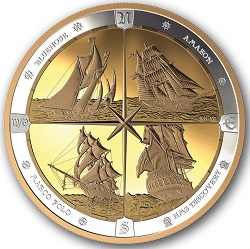
Face value: 125 dollars … Composition:99.99% pure silver with
selective gold plating; Mintage: 500; Finish: proof;
Weight: 502.99 g; Diameter: 85.45 mm; Edge: serrated;
Certificate: serialized; Artist: Neil Hamelin and
Yves Bérubé (reverse), Susanna Blunt (obverse).
Design: The reverse design brings together the four legendary vessels featured in the Royal Canadian Mint’s 2016 Tall Ships Legacy series. Like a compass, the cardinal directions divide the coin’s reverse into four gold-plated quadrants. Each quadrant features a depiction by maritime artists Neil Hamelin and Yves Bérubé. The northeast quadrant, “AMAZON”, features the Nova Scotia brigantine more famously known as the ghost ship Mary Celeste. The southeast quadrant, “HMS DISCOVERY”, features the ship commanded by Captain George Vancouver during his exploration of Canada’s Pacific coast. The southwest quadrant, “MARCO POLO”, features the New Brunswick-built passenger ship that brought immigrants to Australia in the mid-19th century. The northwest quadrant, “BLUENOSE”, features the Nova Scotia fishing schooner that became an international racing legend. Selective gold plating is denoted by a “P” mark on the obverse, which features the effigy of Her Majesty Queen Elizabeth II by Susanna Blunt. Packaging: A limited collecting opportunity, your coin is securely enclosed in a sleek black clamshell and packaged in a black beauty box.

2020 … Pure Silver Coin – Peace Dollar
www.mint.ca www.canadapost.ca
Canada has long been associated with the search for a stable and secure international order. This connection began in 1957 when Lester B. Pearson won the Nobel Peace Prize. Then Canadian Secretary of state for External Affairs, Pearson helped diffuse the Suez Crisis by creating the world’s first, large-scale United Nations peacekeeping force. Over the next 40 years, Canada’s contribution to UN peacekeeping becomes an intrinsic part of the country’s international role. In 1988, the UN received the Nobel Peace Prize for decades of peacekeeping activities. By then, Canada had contributed roughly 80,000 peacekeepers. The Peace dollar celebrates Canada’s dedication to making the world a more peaceful place.
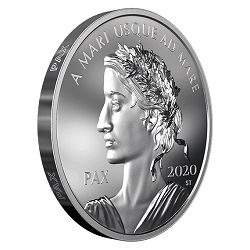
Face value: 1 dollar … Composition: 99.99% pure silver;
Finish: proof; Mintage: 5,500; Weight: 30.76 g;
Diameter: 36.15 mm; Edge: plain with edge lettering;
Certificate: serialized; Artist: Susan Taylor (reverse),
Susanna Blunt (obverse).
Design: The reverse design features the profile of Lady Peace, crowned with maple leaves. Her visage is accompanied by “PAX 2020” and the Canadian national motto: “A MARI USQUE AD MARE” – From Sea to Sea. The coin also bears edge lettering with the Latin word ‘PAX’ which means peace. The obverse design features the effigy of Her Majesty Queen Elizabeth II by Susanna Blunt.
Did you know … * According to the 2018 Global Peace Index, Canada occupies the 6th place on the ranking. Lester B. Pearson was not the only one to receive the Nobel Peace Prize. In 1988, thousands of Canadians among other peacekeepers have been collectively awarded for their service in UN missions. * The Nobel Peace Prize led Canada to establish our own Canadian Peacekeeping Service Medal, now proudly worn by many Veterans. * Following World War I, there was desire in the United States to create a coin symbolic of peace The Peace dollar was first struck on December 28, 1921; just over a million were coined bearing a 1921 date. * The Peace dollar coin was minted from 1921 to 1928, and again in 1934 and 1935.. It was the last United States dollar coin to be struck for circulation in silver. * In 1965, amid much controversy, the Denver mint struck over 316,000 Peace dollars dated 1964, but these were never issued, and all are believed to have been melted. Its obverse represents the head and neck of the Goddess of Liberty in profile, and the reverse depicts a bald eagle at rest clutching an olive branch, with the legend “Peace”. Packaging: Your coin is encapsulated and presented in a Royal Canadian Mint-branded clamshell with a black beauty box.

2020 … Pure Gold Coin – Peace Dollar
www.canadapost.ca www.mint.ca
Canada has long been associated with the search for a stable and secure international order. This connection began in 1957 when Lester B. Pearson won the Nobel Peace Prize. Then Canadian Secretary of state for External Affairs, Pearson helped diffuse the Suez Crisis by creating the world’s first, large-scale United Nations peacekeeping force. Over the next 40 years, Canada’s contribution to UN peacekeeping becomes an intrinsic part of the country’s international role. In 1988, the UN received the Nobel Peace Prize for decades of peacekeeping activities. By then, Canada had contributed roughly 80,000 peacekeepers.
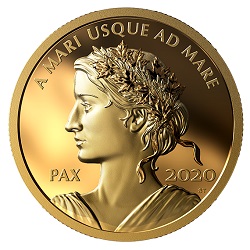
Face value: 200 dollars … Composition: 99.999% pure gold;
Mintage: 500; Finish: proof; Weight: 31.16 g; Diameter: 30 mm;
Edge: interrupted serrations; Certificate: serialized;
Artist: Susan Taylor (reverse), Susanna Blunt (obverse).
Design: The reverse design features the profile of Lady Peace, crowned with maple leaves. Her visage is accompanied by “PAX 2020” and the Canadian national motto: “A MARI USQUE AD MARE” – From Sea to Sea. The coin also bears edge lettering with the Latin word ‘PAX’ which means peace. The obverse design features the effigy of Her Majesty Queen Elizabeth II by Susanna Blunt.
Did you know … According to the 2018 Global Peace Index, Canada occupies the 6th place on the ranking. Lester B. Pearson was not the only one to receive the Nobel Peace Prize. In 1988, thousands of Canadians among other peacekeepers have been collectively awarded for their service in UN missions. The Nobel Peace Prize led Canada to establish our own Canadian Peacekeeping Service Medal, now proudly worn by many Veterans. Following World War I, there was desire in the United States to create a coin symbolic of peace. The Peace dollar was first struck on December 28, 1921; just over a million were coined bearing a 1921 date. The Peace dollar coin was minted from 1921 to 1928, and again in 1934 and 1935. It was the last United States dollar coin to be struck for circulation in silver.
In 1965, amid much controversy, the Denver mint struck over 316,000 Peace dollars dated 1964, but these were never issued, and all are believed to have been melted. Its obverse represents the head and neck of the Goddess of Liberty in profile, and the reverse depicts a bald eagle at rest clutching an olive branch, with the legend “Peace”.


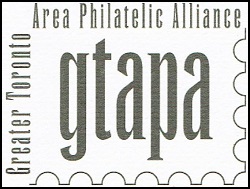
www.gtapa.org
The GTAPA is committed to promote and stimulate
the art of philately to all ages for fun, culture,
education, and friendship.

